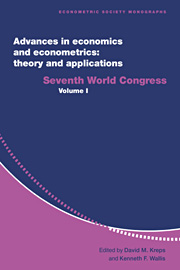Book contents
- Frontmatter
- 1 Trade and wages
- 2 Politics and trade policy
- 3 Economic analysis of political institutions: an introduction
- 4 Game-theoretic models of market structure
- 5 Rationality and knowledge in game theory
- 6 Experiments and the economics of individual decision making under risk and uncertainty
- 7 Theory and experiment in the analysis of strategic interaction
- 8 Evolutionary game theory in economics
- 9 Learning from learning in economics
- Index
8 - Evolutionary game theory in economics
Published online by Cambridge University Press: 05 January 2013
- Frontmatter
- 1 Trade and wages
- 2 Politics and trade policy
- 3 Economic analysis of political institutions: an introduction
- 4 Game-theoretic models of market structure
- 5 Rationality and knowledge in game theory
- 6 Experiments and the economics of individual decision making under risk and uncertainty
- 7 Theory and experiment in the analysis of strategic interaction
- 8 Evolutionary game theory in economics
- 9 Learning from learning in economics
- Index
Summary
INTRODUCTION
The success of game theory in the 1980s has revolutionized economics. In addition to optimization and competitive market equilibrium, the concept of Nash equilibrium became a basic analytical tool and a common language of economists in almost all fields. In his famed text book (1948), Paul Samuelson quoted an epigram: “You can make even a parrot into a learned economist; all it must learn are the two words, 'supply' and 'demand.'” But now the parrot needs two more words, “Nash equilibrium,” to be academically correct.
As the game theoretic approach penetrated into many fields, however, some basic problems became apparent. First, it is not clear how players come to play a Nash equilibrium. Although Nash equilibrium was once perceived as the outcome of perfectly rational reasoning, active research in the past decade revealed that common knowledge of rationality only implies rationalizability, which is much weaker than Nash equilibrium. Second, game theoretic models quite often possess multiple equilibria which have markedly different properties. This is in contrast to the general equilibrium model where all equilibria are efficient. Hence in applications of game theory it is vital to pin down which equilibrium is selected. A host of refinements literature tried to solve this problem by defining a stronger notion of rationality than Nash equilibrium assumes, but it was not entirely successful. We are left with a number of new solution concepts, and there seems to be no clear consensus among economists as to which one is right.
- Type
- Chapter
- Information
- Advances in Economics and Econometrics: Theory and ApplicationsSeventh World Congress, pp. 243 - 277Publisher: Cambridge University PressPrint publication year: 1997



